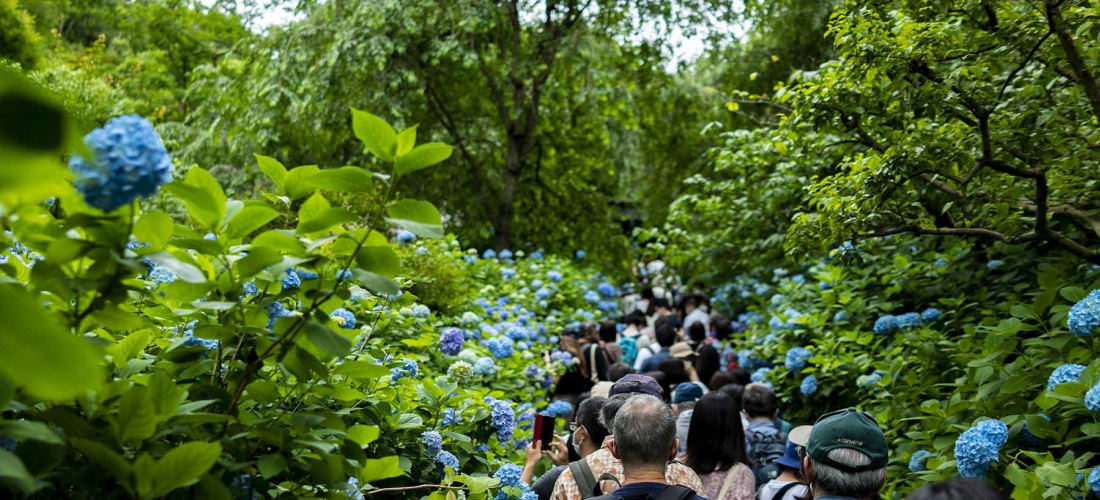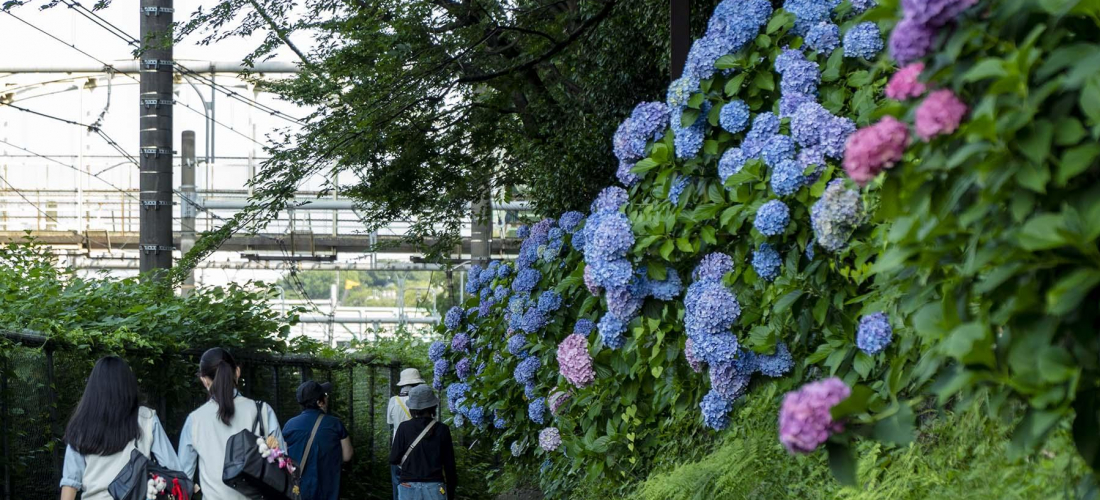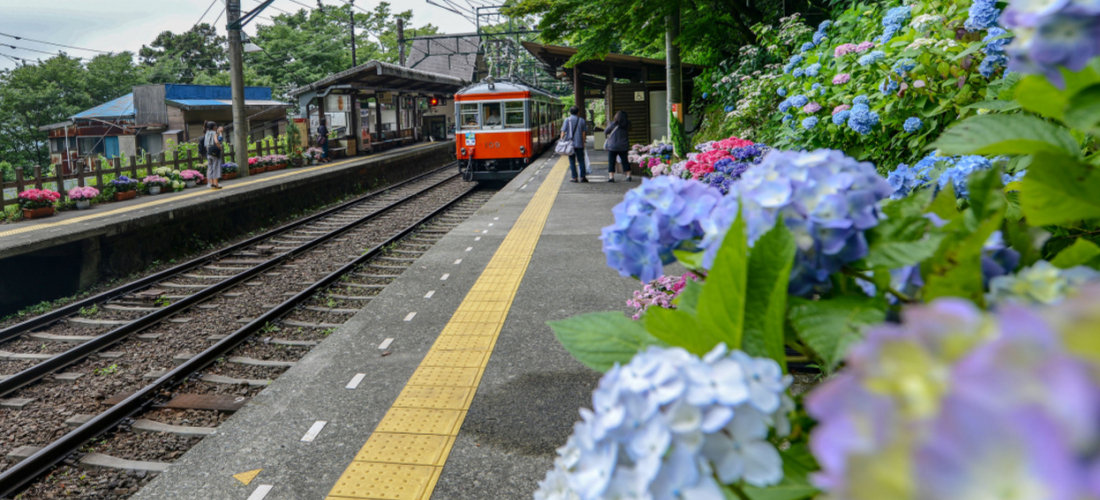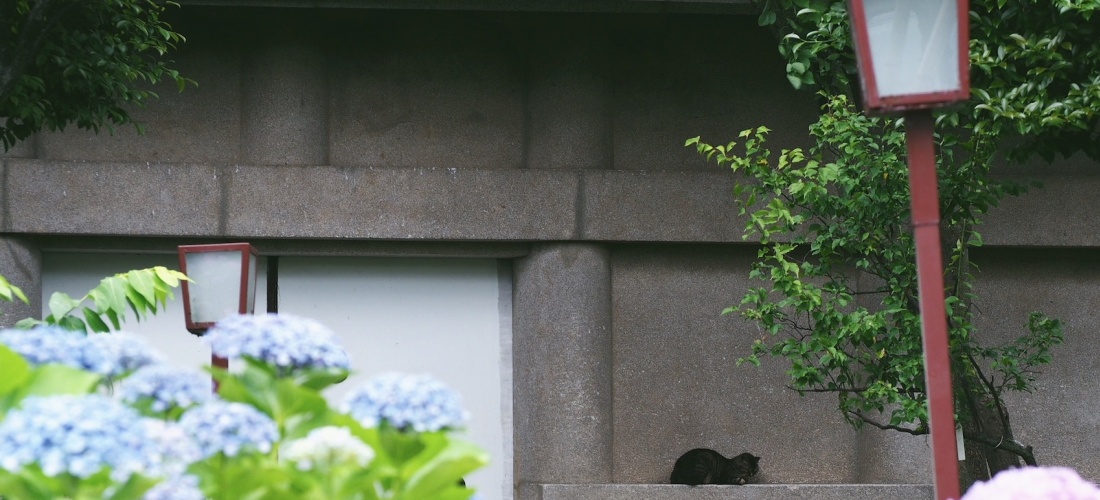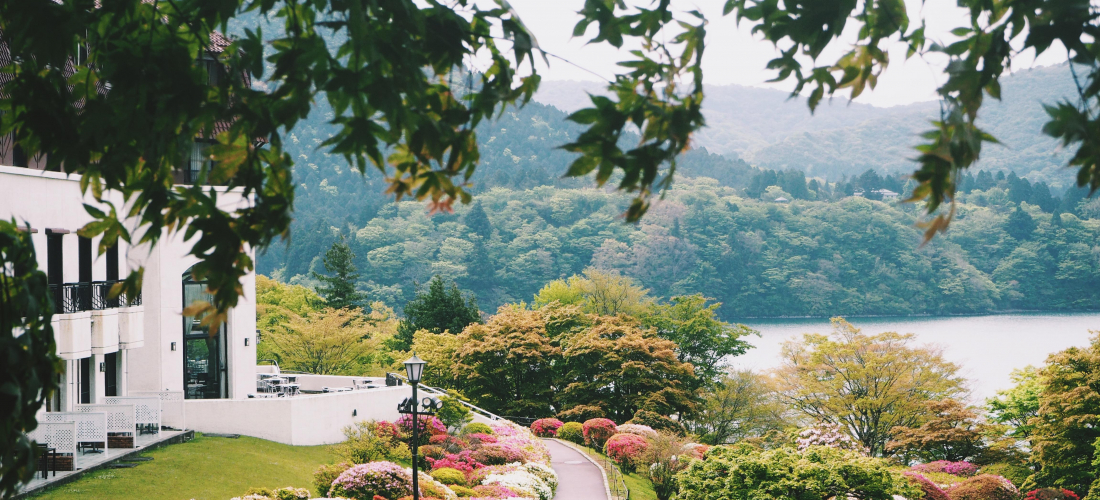CONTENTS
In Japan, June means hydrangeas, so don’t miss the chance to see these beautiful Tokyo flower gardens before the season ends!
Hydrangeas in and Around Tokyo
Blooming hydrangeas signal the arrival of summer in regions all over the world, but in Japan, where the changing of the seasons has long been a part of art and culture, hydrangeas and hydrangea viewing have become a yearly full-blown event. Temples and shrines open their verdant hydrangea gardens to the public, and hydrangea festivals all over the country give passionate gardeners a chance to show off the incredible variety of colors, shapes, and sizes these simple flowers can be coaxed into. Of course, the crowds who go hydrangea viewing every year aren't just fawning over one or two hydrangea bushes like you might see in a home garden! Japanese hydrangea gardens are dreamy destinations, usually filled with countless plants growing huge puffs of multi-colored petals, and narrow paths lined with tall bushes with pale blue flowers. When mid-June rolls around, there's no better way to spend a day in the Tokyo area than a little hydrangea viewing.
Travelers take note! In Japan, hydrangea season coincides pretty perfectly with tsuyu, Japan's rainy season! But a little rain shouldn't stop you from enjoying the flowers. Many will tell you that flower viewing is perfectly lovely even when it's a little damp out, and some say that hydrangeas in the rain are especially beautiful. It just means you should take some precautions and dress for the season! If you want to be prepared for the weather and still look great in photos with the flowers, we recommend this Japanese hydrangea print dress, a handmade waterproof bag from one of Japan's many fashionable creators, and of course a nice umbrella to match – the polka dots on this Yayoi Kusama umbrella look a little like raindrops, or maybe a little like blue hydrangeas.
➡ Hakusan Shrine
This small and inconspicuous shrine in central Tokyo might not stand out for much of the year, but Hakusan Shrine actually has a history stretching back to the mid-10th century, and a hydrangea garden that blows visitors away to this day. Every year, at the peak of the blooming season, Hakusan Shrine hosts the Bunkyo Hydrangea Festival to show off the 3,000 or more hydrangea bushes that fill up the shrine grounds and the neighboring Hakusan Park. Classic hydrangeas bloom pale blue and purple along the path leading to the shrine's main hall, and a myriad of other rare and unique hydrangea varieties can be found dotted around the grounds, from the unusually shaped "tea of heaven" bushes that come from high in the Japanese mountains, to foreign plants imported from America and France. The shrine even has its own "mountain" on the premises – a small hill covered entirely with hydrangeas, which has been dubbed the "Hydrangea Mt. Fuji." Most years, this small gated hill is only open to the public for a handful of days during the festival, but in recent years COVID has put a stop to visitors entering the area entirely. But the festival does still include musical performances, and even an opportunity for dental consultations!
Hakusan Shrine (白山神社)
5-31-26 Hakusan, Bunkyo City, Tokyo
Official Website (jp)
➡ Sumida Park
The Sumida River functions as the eastern border of Tokyo's Asakusa neighborhood, and visitors who venture over to the riverbank will find one long public park stretched out along the water, lined with flowerbeds and studded with benches and bridges. The hydrangeas in Sumida Park aren't as densely packed as some other spots, but brilliant bunches of the flowers can be seen all along the path, which has been dubbed "Hydrangea Road" (あじさいロード). After wading through the busy streets around Sensoji Temple on a humid early summer day in Tokyo, a walk along the broad, breezy paths of this public park is a perfect break from the crowds, especially when you get a chance to admire the 10,000 hydrangea bushes that are blooming along the way. It's also an ideal place to get some incredible photos of Tokyo Skytree with the flowers!
▶ More about Asakusa and Sumida Park.
Sumida Park (隅田公園)
1 Chome Hanakawado, Taito City, Tokyo
Official Webpage (jp)
➡ Meigetsuin Temple
Meigetsuin Temple isn't in Tokyo, but making the hour-long trek down to the nearby city of Kamakura is well worth it each June, when this temple becomes a sea of blue flowers. The temple was originally built in 1160, and it's strongly associated with a 13th-century Kamakura shogun regent named Hojo Tokiyori, but these days the temple is so famous for its flowers that it's earned the nickname Ajisai-dera (紫陽花寺/Hydrangea Temple). Meigetsuin may have fewer flower bushes than other hydrangea spots (estimates count the number around 2,500), but to many visitors this spot is the most impressive of the bunch, thanks to the hydrangeas that line up like hedgerows along the winding temple paths and create a secluded secret garden atmosphere, even when the temple is packed with people. The hydrangeas that crowd Meigetsuin's grounds are almost all a variety that goes by the name "princess hydrangea" (姫アジサイ/hime-ajisai), and the blooms are all a light blue that does seem to match Cinderella's ballgown, but here the sky blue petals add an extra dose of magic to this temple garden.
While you're there, don't forget to catch a glimpse through the temple's famous circular window, which looks out onto the back garden of the temple. During limited periods in early summer and again in autumn, visitors can pay an extra fee to go back into the second garden to see irises or beautiful fall foliage.
▶ More about Kamakura sightseeing.
Meigetsuin Temple (明月院)
189 Yamanouchi, Kamakura, Kanagawa
Kamakura Tourism Page (jp)
Go Hydrangea Hopping This June
One of the nicest things about flower viewing in Japan is that beautiful blooms can be found in just about every direction, and that includes hydrangeas. So whether you spend June traveling from one famous garden to another, or you just take a moment to admire hydrangea bushes planted along the sidewalk in the middle of Tokyo, keep an eye out for the beautiful flowers wherever you go this summer!
(And don't forget to prepare yourself for rainy season, either!)
Details
NAME:Hydrangeas
Looking for the latest trends and products coming out of Japan? We've got you covered!
COMMENT
FEATURED MEDIA
VIEW MORE 
A New Tokyo Animal Destination: Relax & Learn About the World’s Animals in Japan
#pr #japankuru #anitouch #anitouchtokyodome #capybara #capybaracafe #animalcafe #tokyotrip #japantrip #카피바라 #애니터치 #아이와가볼만한곳 #도쿄여행 #가족여행 #東京旅遊 #東京親子景點 #日本動物互動體驗 #水豚泡澡 #東京巨蛋城 #เที่ยวญี่ปุ่น2025 #ที่เที่ยวครอบครัว #สวนสัตว์ในร่ม #TokyoDomeCity #anitouchtokyodome

Shohei Ohtani Collab Developed Products & Other Japanese Drugstore Recommendations From Kowa
#pr #japankuru
#kowa #syncronkowa #japanshopping #preworkout #postworkout #tokyoshopping #japantrip #일본쇼핑 #일본이온음료 #오타니 #오타니쇼헤이 #코와 #興和 #日本必買 #日本旅遊 #運動補充能量 #運動飲品 #ช้อปปิ้งญี่ปุ่น #เครื่องดื่มออกกำลังกาย #นักกีฬา #ผลิตภัณฑ์ญี่ปุ่น #อาหารเสริมญี่ปุ่น

도쿄 근교 당일치기 여행 추천! 작은 에도라 불리는 ‘가와고에’
세이부 ‘가와고에 패스(디지털)’ 하나면 편리하게 이동 + 가성비까지 완벽하게! 필름카메라 감성 가득한 레트로 거리 길거리 먹방부터 귀여움 끝판왕 핫플&포토 스폿까지 총집합!
Looking for day trips from Tokyo? Try Kawagoe, AKA Little Edo!
Use the SEIBU KAWAGOE PASS (Digital) for easy, affordable transportation!
Check out the historic streets of Kawagoe for some great street food and plenty of picturesque retro photo ops.
#pr #japankuru #도쿄근교여행 #가와고에 #가와고에패스 #세이부패스 #기모노체험 #가와고에여행 #도쿄여행코스 #도쿄근교당일치기 #세이부가와고에패스
#tokyotrip #kawagoe #tokyodaytrip #seibukawagoepass #kimono #japantrip

Hirakata Park, Osaka: Enjoy the Classic Japanese Theme Park Experience!
#pr #japankuru #hirakatapark #amusementpark #japantrip #osakatrip #familytrip #rollercoaster #retrôvibes #枚方公園 #大阪旅遊 #關西私房景點 #日本親子旅行 #日本遊樂園 #木造雲霄飛車 #히라카타파크 #สวนสนุกฮิราคาตะพาร์ค

🍵Love Matcha? Upgrade Your Matcha Experience With Tsujiri!
・160년 전통 일본 말차 브랜드 츠지리에서 말차 덕후들이 픽한 인기템만 골라봤어요
・抹茶控的天堂!甜點、餅乾、飲品一次滿足,連伴手禮都幫你列好清單了
・ส่องมัทฉะสุดฮิต พร้อมพาเที่ยวร้านดังในอุจิ เกียวโต
#pr #japankuru #matcha #matchalover #uji #kyoto #japantrip #ujimatcha #matchalatte #matchasweets #tsujiri #말차 #말차덕후 #츠지리 #교토여행 #말차라떼 #辻利抹茶 #抹茶控 #日本抹茶 #宇治 #宇治抹茶 #日本伴手禮 #抹茶拿鐵 #抹茶甜點 #มัทฉะ #ของฝากญี่ปุ่น #ชาเขียวญี่ปุ่น #ซึจิริ #เกียวโต

・What Is Nenaito? And How Does This Sleep Care Supplement Work?
・你的睡眠保健品——認識「睡眠茶氨酸錠」
・수면 케어 서플리먼트 ‘네나이토’란?
・ผลิตภัณฑ์เสริมอาหารดูแลการนอน “Nenaito(ネナイト)” คืออะไร?
#pr #japankuru #sleepcare #japanshopping #nenaito #sleepsupplement #asahi #睡眠茶氨酸錠 #睡眠保健 #朝日 #l茶胺酸 #日本藥妝 #日本必買 #일본쇼핑 #수면 #건강하자 #네나이토 #일본영양제 #อาหารเสริมญี่ปุ่น #ช้อปปิ้งญี่ปุ่น #ร้านขายยาญี่ปุ่น #ดูแลตัวเองก่อนนอน #อาซาฮิ

Japanese Drugstore Must-Buys! Essential Items from Hisamitsu® Pharmaceutical
#PR #japankuru #hisamitsu #salonpas #feitas #hisamitsupharmaceutical #japanshopping #tokyoshopping #traveltips #japanhaul #japantrip #japantravel

Whether you grew up with Dragon Ball or you just fell in love with Dragon Ball DAIMA, you'll like the newest JINS collab. Shop this limited-edition Dragon Ball accessory collection to find some of the best Dragon Ball merchandise in Japan!
>> Find out more at Japankuru.com! (link in bio)
#japankuru #dragonball #dragonballdaima #animecollab #japanshopping #jins #japaneseglasses #japantravel #animemerch #pr

This month, Japankuru teamed up with @official_korekoko to invite three influencers (originally from Thailand, China, and Taiwan) on a trip to Yokohama. Check out the article (in Chinese) on Japankuru.com for all of their travel tips and photography hints - and look forward to more cool collaborations coming soon!
【橫濱夜散策 x 教你怎麼拍出網美照 📸✨】
每次來日本玩,是不是都會先找旅日網紅的推薦清單?
這次,我們邀請擁有日本豐富旅遊經驗的🇹🇭泰國、🇨🇳中國、🇹🇼台灣網紅,帶你走進夜晚的橫濱!從玩樂路線到拍照技巧,教你怎麼拍出最美的夜景照。那些熟悉的景點,換個視角說不定會有新發現~快跟他們一起出發吧!
#japankuru #橫濱紅磚倉庫 #汽車道 #中華街 #yokohama #japankuru #橫濱紅磚倉庫 #汽車道 #中華街 #yokohama #yokohamaredbrickwarehouse #yokohamachinatown

If you’re a fan of Vivienne Westwood's Japanese designs, and you’re looking forward to shopping in Harajuku this summer, we’ve got important news for you. Vivienne Westwood RED LABEL Laforet Harajuku is now closed for renovations - but the grand reopening is scheduled for July!
>> Find out more at Japankuru.com! (link in bio)
#japankuru #viviennewestwood #harajuku #omotesando #viviennewestwoodredlabel #viviennewestwoodjapan #비비안웨스트우드 #오모테산도 #하라주쿠 #日本購物 #薇薇安魏斯伍德 #日本時尚 #原宿 #表參道 #japantrip #japanshopping #pr

Ready to see TeamLab in Kyoto!? At TeamLab Biovortex Kyoto, the collective is taking their acclaimed immersive art and bringing it to Japan's ancient capital. We can't wait to see it for ourselves this autumn!
>> Find out more at Japankuru.com! (link in bio)
#japankuru #teamlab #teamlabbiovortex #kyoto #kyototrip #japantravel #artnews
Photos courtesy of teamLab, Exhibition view of teamLab Biovortex Kyoto, 2025, Kyoto ® teamLab, courtesy Pace Gallery

Japanese Makeup Shopping • A Trip to Kamakura & Enoshima With Canmake’s Cool-Toned Summer Makeup
#pr #canmake #enoshima #enoden #에노시마 #캔메이크 #japanesemakeup #japanesecosmetics

⚔️The Robot Restaurant is gone, but the Samurai Restaurant is here to take its place. Check it out, and don't forget your coupon!
🍣신주쿠의 명소 로봇 레스토랑이 사무라이 레스토랑으로 부활! 절찬 쿠폰 발급중
💃18歲以上才能入場的歌舞秀,和你想的不一樣!拿好優惠券去看看~
#tokyo #shinjuku #samurairestaurant #robotrestaurant #tokyotrip #도쿄여행 #신주쿠 #사무라이레스토랑 #이색체험 #할인이벤트 #歌舞伎町 #東京景點 #武士餐廳 #日本表演 #日本文化體驗 #japankuru #japantrip #japantravel #japanlovers #japan_of_insta

Japanese appliance & electronics shopping with our KOJIMA x BicCamera coupon!
用JAPANKURU的KOJIMA x BicCamera優惠券買這些正好❤️
코지마 x 빅 카메라 쿠폰으로 일본 가전 제품 쇼핑하기
#pr #japankuru #japanshopping #kojima #biccamera #japaneseskincare #yaman #dji #osmopocket3 #skincaredevice #日本購物 #美容儀 #相機 #雅萌 #日本家電 #일본여행 #면세 #여행꿀팁 #일본쇼핑리스트 #쿠폰 #일본쇼핑 #일본브랜드 #할인 #코지마 #빅카메라 #japankurucoupon

